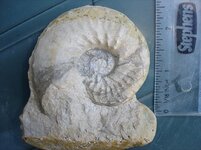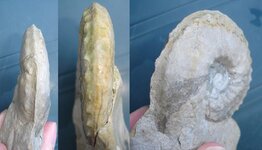- Joined
- Nov 19, 2002
- Messages
- 3,031
Hi all,
This rather stunning ammonite was found buried in an outcrop of Gault Clay at Folkestone in Kent. I am not certain what type of ammonite it is, but suspect it is something akin to Hysteroceras. This fossil was apparantly poking out of a clay outcrop amongst the beach sand with just a small piece of keel projecting. This ammonite was certainly discovered in the Upper Gault beds and close the chalk boundary, dating it to the upper Albian, Lower Cretaceous. It has a pronounced keel, and is I think, is pretty much intact.
Any opinions on my ID anyone? I can supply better resolution pics if required.
(Mandy, if you read this, I insist on walking the dogs with you next time if you are to find things like this. In five years I've never found anything this good! Bah. )
)
This rather stunning ammonite was found buried in an outcrop of Gault Clay at Folkestone in Kent. I am not certain what type of ammonite it is, but suspect it is something akin to Hysteroceras. This fossil was apparantly poking out of a clay outcrop amongst the beach sand with just a small piece of keel projecting. This ammonite was certainly discovered in the Upper Gault beds and close the chalk boundary, dating it to the upper Albian, Lower Cretaceous. It has a pronounced keel, and is I think, is pretty much intact.
Any opinions on my ID anyone? I can supply better resolution pics if required.
(Mandy, if you read this, I insist on walking the dogs with you next time if you are to find things like this. In five years I've never found anything this good! Bah.


